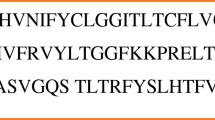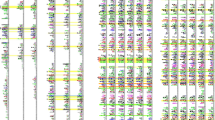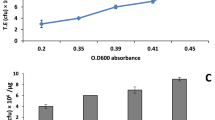Abstract
Peroxidases are oxidoreductase enzymes that widely gained attention as biocatalysts for their robust catalytic activity, specificity, and regioselective functionality for phenolic compounds. The study of molecular aspects of peroxidases is as crucial as that of the physicochemical aspects. A bioinformatics approach is utilized in this study to investigate the structural aspects and functions of luffa peroxidase (LPrx) from Luffa acutangula. The evolutionary relationship of LPrx with other class III peroxidases was studied by constructing a neighbour-joining phylogenetic tree. An analysis of the phylogenetic tree revealed that plant peroxidases share a common ancestor. The gene ontology term showed that LPrx had a molecular functionality of the oxidation–reduction process, heme binding and peroxidase-like activity, and the biological function of hydrogen peroxide scavenging activity. The enzyme-ligand interactions were studied from a catalytic point of view using the molecular docking technique. The molecular docking was carried out with LPrx as a receptor and guaiacol, m-cresol, p-cresol, catechol, quinol, pyrogallol, 2,4-dimethoxyphenol, gallic acid, aniline, and o-phenylenediamine as ligands. The results presented in the current communication will have a significant implication in proteomics, biochemistry, biotechnology, and the potential applications of peroxidases in the biotransformations of organic compounds.










Similar content being viewed by others
Data availability
All data generated or analysed during this study are available within the article.
References
Acebes S, Ruiz-Dueñas FJ, Toubes M et al (2017) Mapping the long-range electron transfer route in ligninolytic peroxidases. J Phys Chem B 121:3946–3954
Baker MR, Zhao H, Sakharov IY, Li QX (2014) Amino acid sequence of anionic peroxidase from the windmill palm tree Trachycarpus fortunei. J Agric Food Chem 62:11941–11948. https://doi.org/10.1021/jf504511h
Basumatary D, Yadav M, Nath P, Yadav HS (2020) Catalytic biotransformations and inhibition study of peroxidase from Luffa aegyptiaca. Curr Organocatalysis. https://doi.org/10.2174/2213337207666200211095038
Berglund GI, Carlsson GH, Smith AT et al (2002) The catalytic pathway of horseradish peroxidase at high resolution. Nature 417:463–468. https://doi.org/10.1038/417463a
Bienert S, Waterhouse A, De Beer TAP et al (2017) The SWISS-MODEL Repository—new features and functionality. Nucleic Acids Res 45:D313–D319
Cai F, Zhu Q, Zhao K et al (2015) Multiple signal amplified electrochemiluminescent immunoassay for Hg2+ using graphene-coupled quantum dots and gold nanoparticles-labeled horseradish peroxidase. Environ Sci Technol 49:5013–5020
Combet C, Blanchet C, Geourjon C, Deleage G (2000) NPS@: network protein sequence analysis. Trends Biochem Sci 25:147–150
Du X, Li Y, Xia Y-L et al (2016) Insights into protein–ligand interactions: mechanisms, models, and methods. Int J Mol Sci 17:144
Eisenberg D, Lüthy R, Bowie JU (1997) VERIFY3D: Assessment of protein models with three-dimensional profiles. Methods Enzymol 277:396–404. https://doi.org/10.1016/s0076-6879(97)77022-8
Flohé L, Toppo S, Orian L (2022) The glutathione peroxidase family: Discoveries and mechanism. Free Radic Biol Med 187:113–122
Gasteiger E, Hoogland C, Gattiker A et al (2005) Protein identification and analysis tools on the ExPASy server. In: Walker John M (ed) proteomics Protoc Handb. Humana Press, Totowa, NJ, pp 571–607
Hark Gan H, Perlow RA, Roy S et al (2002) Analysis of protein sequence/structure similarity relationships. Biophys J 83:2781–2791. https://doi.org/10.1016/S0006-3495(02)75287-9
Herrero J, Fernández-Pérez F, Yebra T et al (2013) Bioinformatic and functional characterization of the basic peroxidase 72 from Arabidopsis thaliana involved in lignin biosynthesis. Planta 237:1599–1612
Ikai A (1980) Thermostability and aliphatic index of globular proteins. J Biochem 88:1895–1898
Kim SJ, Lee JA, Joo JC et al (2010) The development of a thermostable CiP (Coprinus cinereus peroxidase) through in silico design. Biotechnol Prog 26:1038–1046
Kumar S, Bhardwaj VK, Singh R et al (2022) Identification of acridinedione scaffolds as potential inhibitor of DENV-2 C protein: An in silico strategy to combat dengue. J Cell Biochem 123(5):935–946
Kumar S, Bhardwaj VK, Singh R, Purohit R (2021) Explicit-solvent molecular dynamics simulations revealed conformational regain and aggregation inhibition of I113T SOD1 by Himalayan bioactive molecules. J Mol Liq 339:116798
Kyte J, Doolittle RF (1982) A simple method for displaying the hydropathic character of a protein. J Mol Biol 157:105–132
Laskowski RA, MacArthur MW, Moss DS, Thornton JM (1993) PROCHECK: a program to check the stereochemical quality of protein structures. J Appl Crystallogr 26:283–291
Morsi R, Bilal M, Iqbal HMN, Ashraf SS (2020) Laccases and peroxidases: The smart, greener and futuristic biocatalytic tools to mitigate recalcitrant emerging pollutants. Sci Total Environ 714:136572. https://doi.org/10.1016/J.SCITOTENV.2020.136572
Moyo M (2014) Horseradish peroxidase biosensor to detect zinc ions in aqueous solutions. Open J Appl Biosens 3(1):1–7
Moyo M, Okonkwo JO (2014) Horseradish peroxidase biosensor based on maize tassel–MWCNTs composite for cadmium detection. Sens Actuators B Chem 193:515–521
Nokthai P, Lee VS, Shank L (2010) Molecular modeling of peroxidase and polyphenol oxidase: substrate specificity and active site comparison. Int J Mol Sci 11:3266–3276
Nomngongo PN, Ngila JC, Nyamori VO et al (2011) Determination of selected heavy metals using amperometric horseradish peroxidase (HRP) inhibition biosensor. Anal Lett 44:2031–2046
Pandey VP, Awasthi M, Singh S et al (2017) A comprehensive review on function and application of plant peroxidases. Biochem Anal Biochem 6:308
Pandey VP, Singh S, Jaiswal N et al (2013) Papaya fruit ripening: ROS metabolism, gene cloning, characterization and molecular docking of peroxidase. J Mol Catal B Enzym 98:98–105. https://doi.org/10.1016/j.molcatb.2013.10.005
Saitou N, Nei M (1987) The neighbor-joining method: a new method for reconstructing phylogenetic trees. Mol Biol Evol 4:406–425
Singh AK, Bilal M, Iqbal HMN, Raj A (2022a) In silico analytical toolset for predictive degradation and toxicity of hazardous pollutants in water sources. Chemosphere 292:133250
Singh AK, Katari SK, Umamaheswari A, Raj A (2021a) In silico exploration of lignin peroxidase for unraveling the degradation mechanism employing lignin model compounds. RSC Adv 11:14632–14653
Singh I, Shah K (2014) Evidences for structural basis of altered ascorbate peroxidase activity in cadmium-stressed rice plants exposed to jasmonate. Biometals 27:247–263. https://doi.org/10.1007/s10534-014-9705-z
Singh R, Bhardwaj VK, Das P, Purohit R (2022b) Identification of 11β-HSD1 inhibitors through enhanced sampling methods. Chem Commun 58:5005–5008
Singh R, Bhardwaj VK, Das P, Purohit R (2021b) New ecdysone receptor agonists: a computational approach for rational discovery of insecticides for crop protection. Mol Syst Des Eng 6:936–945
Singh R, Bhardwaj VK, Purohit R (2022c) Computational targeting of allosteric site of MEK1 by quinoline-based molecules. Cell Biochem Funct 40:481–490
Singh R, Kumar S, Bhardwaj VK, Purohit R (2022d) Screening and reckoning of potential therapeutic agents against DprE1 protein of Mycobacterium tuberculosis. J Mol Liq 358:119101
Thiede B, Höhenwarter W, Krah A et al (2005) Peptide mass fingerprinting. Methods 35:237–247
Trott O, Olson AJ (2010) AutoDock Vina: improving the speed and accuracy of docking with a new scoring function, efficient optimization, and multithreading. J Comput Chem 31:455–461
Veitch NC (2004) Horseradish peroxidase: a modern view of a classic enzyme. Phytochemistry 65:249–259
Wallner B, Elofsson A (2003) Can correct protein models be identified? Protein Sci 12:1073–1086
Webster J, Oxley D (2012) Protein identification by MALDI-TOF mass spectrometry. In: Zanders Edward D (ed) Chemical genomics and proteomics. Springer, Totowa, NJ, pp 227–240
Wiederstein M, Sippl MJ (2007) ProSA-web: interactive web service for the recognition of errors in three-dimensional structures of proteins. Nucleic Acids Res 35:W407–W410. https://doi.org/10.1093/nar/gkm290
Yadav M, Rai N, Yadav HS (2017) The role of peroxidase in the enzymatic oxidation of phenolic compounds to quinones from Luffa aegyptiaca (gourd) fruit juice. Green Chem Lett Rev 10:154–161
Yang J, Yan R, Roy A et al (2015) The I-TASSER Suite: protein structure and function prediction. Nat Methods 12:7–8. https://doi.org/10.1038/nmeth.3213
Zhang L, Skolnick J (1998) What should the Z-score of native protein structures be? Protein Sci 7:1201–1207. https://doi.org/10.1002/pro.5560070515
Acknowledgements
The authors thank the Department of Chemistry, North Eastern Regional Institute of Science and Technology, Nirjuli, Arunachal Pradesh, India, for providing adequate lab facilities and the Sandor Speciality Diagnostics Pvt. Ltd. for the MALDI-TOF MS data. The authors also thank the Ministry of Tribal Affairs, New Delhi, India, for providing fellowship to Dencil Basumatary under the “National Fellowship and Scholarship for Higher Education for ST Students” scheme.
Author information
Authors and Affiliations
Contributions
DB has performed all experimental and software analyses and written the manuscript. SS has investigated and edited the manuscript. HSY and MY supervised and reviewed the manuscript. All authors reviewed and approved the final manuscript.
Corresponding author
Ethics declarations
Conflict of interest
The authors declare no conflict of interest in any materials discussed in this article.
Consent for publication
This article does not contain any studies with human or animal subjects.
Supplementary Information
Below is the link to the electronic supplementary material.
Rights and permissions
Springer Nature or its licensor (e.g. a society or other partner) holds exclusive rights to this article under a publishing agreement with the author(s) or other rightsholder(s); author self-archiving of the accepted manuscript version of this article is solely governed by the terms of such publishing agreement and applicable law.
About this article
Cite this article
Basumatary, D., Saikia, S., Yadav, H.S. et al. In silico analysis of peroxidase from Luffa acutangula. 3 Biotech 13, 25 (2023). https://doi.org/10.1007/s13205-022-03432-8
Received:
Accepted:
Published:
DOI: https://doi.org/10.1007/s13205-022-03432-8




